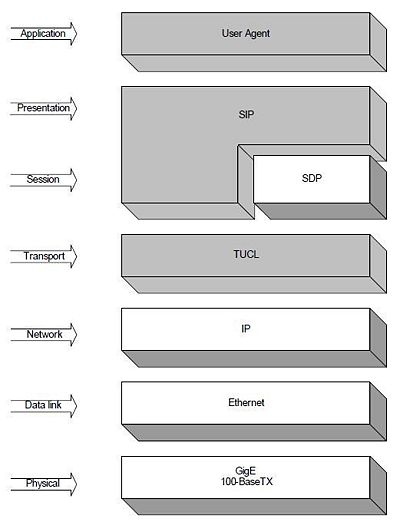Glossary: SIP
Session Initiation Protocol, more commonly known as SIP, is a signaling protocol for packet-based networks and is commonly used, along with H.323 to provide signaling for voice over IP (VoIP) communications.
TelcoBridges and SIP
Toolpack provides support for signaling using the Session Initiation Protocol, more commonly known as SIP, for voice over IP (VoIP) communications. SIP may be used in conjunction with various voice codecs for the media component of a call. TelcoBridges Tmedia media gateways and Tdev development platforms support SIP signaling concurrently with SS7, ISDN and other signaling protocols.
SIP signaling stacks are configured for IP applications and for each Tmedia or Tdev unit requiring SIP signaling.
Based upon your system requirements, you can configure a SIP stack to carry signaling traffic over multiple transport servers, which are IP endpoints comprised of: protocol type (UDP, TCP or TLS), port number and IP interface.
A conceptual illustration is provided below:

While TelcoBridges media gateways can perform multiple simultaneous functions such as switching and transcoding as well as deliver value-added services such as IVR or conferencing, they can also be configured to perform a single function. In this case, it is possible to configure TelcoBridges media gateway to act as a SIP gateway, or an SBC.
TelcoBridges' SIP Implementation
TelcoBridges' SIP implementation works on top of a couple of layers, including SIP and TUCL. In the following figure, grey boxes represent entities that need allocation on the TelcoBridges equipment. The TUCL layer is a transport layer used by SIP on our architecture. TUCL presents some advantages over a simple TCP/IP stack. For instance, it adds tracing facilities to any virtual interface.

Supported SIP RFCs
TelcoBridges supports the following RFCs for SIP:
RFC 2327 Session Description Protocol
Yes
Complete
Complete
RFC 2833 RTP Payload for DTMF Digits, Telephony Tones and Telephony Signals
Yes
Complete
Complete
RFC 2976 SIP INFO Method
Yes
Complete
Partial: For DTMF Tones exchange only
RFC 3204 MIME media types for ISUP and QSIG Objects
Yes
Complete
Complete
RFC 3261 Session Initiate Protocol
Yes
Complete
Complete
RFC 3262 Reliability of Provisional Responses in the Session Initiation Protocol (SIP)
Yes
Complete
Complete
RFC 3263 Session Initiation Protocol (SIP): Locating SIP Servers
Yes
Complete
Complete
RFC 3264 An Offer/Answer Model with the Session Description Protocol (SDP)
Yes
Complete
Partial ('Indicating capabilities' not supported)
RFC 3265 Session Initiation Protocol (SIP)-Specific Event Notification
Yes
No
No
RFC 3311 The Session Initiation Protocol (SIP) UPDATE Method
Yes
Partial (Only For Session Timer Refresh)
Partial: For Session Timer Refresh and SDP reception following a SIP INVITE that had no body
RFC 3323 A Privacy Mechanism for the Session Initiation Protocol (SIP)
Yes
Partial1
Partial1
RFC 3325 Private Extensions to the Session Initiation Protocol (SIP) for Asserted Identity within Trusted Networks
Yes
Partial (No P-Preferred-Identity)
Partial (No P-Preferred-Identity)
RFC 3326 The Reason Header Field for the Session Initiation Protocol (SIP)
Yes
Complete
Complete
RFC 3372 Session Initiation Protocol for Telephones (SIP-T)
Yes
Partial (no ISUP MIME bodies Encryption support)
Partial (no ISUP MIME bodies Encryption support)
RFC 3389 Real-time Transport Protocol (RTP) Payload for Comfort Noise (CN)
Yes
Complete
Complete
RFC 3398 ISUP-SIP Mapping
Yes
Complete
Complete
RFC 3515 Refer Method
Yes
Complete
Complete
RFC 3551 RTP Profile for Audio and Video Conferences with Minimal Control
Yes
Partial (For supported audio codecs, single channel)
Partial (For supported audio codecs, single channel)
RFC 3555 MIME Type Registration of RTP Payload Formats
Yes
Partial (For supported audio codecs)
Partial (For supported audio codecs)
RFC 3578 Overlap
Yes
Partial (Conversion of ISUP Overlap Signalling into SIP en-bloc Signalling)
Partial (Conversion of ISUP Overlap Signalling into SIP en-bloc Signalling)
RFC 3581 An Extension to the Session Initiation Protocol (SIP) for Symmetric Response Routing
Yes
Complete
Complete
RFC 3665 Session Initiation Protocol (SIP) Basic Call Flow Examples
Yes
Partial*
Partial*
RFC 3666 Public Switched Telephone Network (PSTN) Call Flows
Yes
Complete
Complete
RFC 3764 enumservice registration for Session Initiation Protocol (SIP) Addresses-of-Record
Yes
Complete
Complete
RFC 3891 "Replaces" Header
Yes
Complete
Complete
RFC 3892 Referred-By Mechanism
Yes
No
No
RFC 4028 Session Timers in the Session Initiation Protocol (SIP)
Yes
Complete
Complete
RFC 4694 Number Portability Parameters for the "tel" URI
Yes
Yes
Partial (relay of rn and npdi SIP<->SS7)
RFC 4733 RTP Payload for DTMF Digits, Telephony Tones and Telephony Signals
Yes
Complete
Complete
RFC 5246 - The Transport Layer Security (TLS) Protocol Version 1.2
Yes
Yes
Yes
RFC 5630 - The Use of the SIPS URI Scheme in the Session Initiation Protocol
Yes
Yes
Yes
RFC 5806 Diversion Indication in SIP
Yes
Yes
Unconditional forward scenario
[1] For more information please contact customer support.
Maximum Capacity
TMG800
2.2-2.5
4
10
256
2.6+
16
16
512
TMG3200
2.2-2.5
4
10
256
2.6+
16
16
512
TMG7800
2.2-2.5
64 (4/Tmedia)
160 (10/Tmedia)
256
2.6+
256 (16/Tmedia)
256 (16/Tmedia)
512
References
Last updated
Was this helpful?
